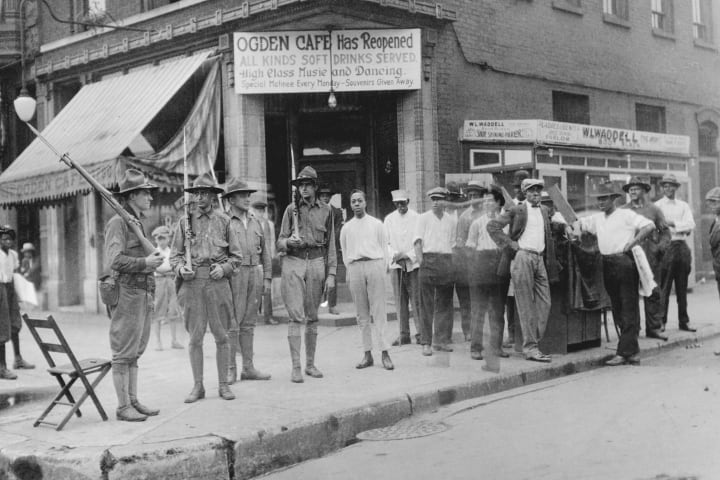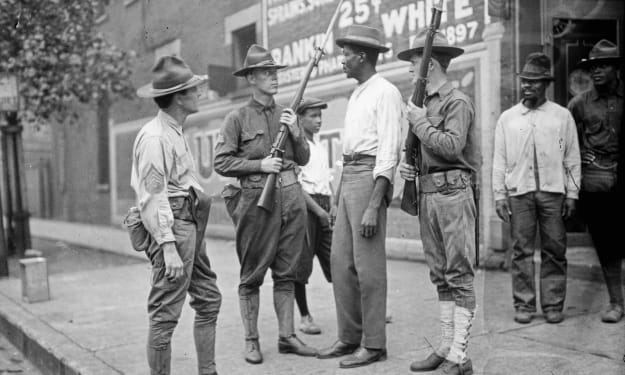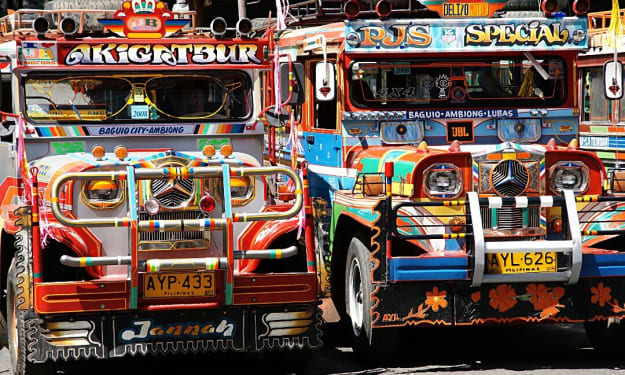The Red Summer - Charleston
United States History Untold

The Red Summer -- Charleston
The history of the United States has to be understood to begin to understand the racial problems experienced by Blacks in this country. Lynchings of Blacks and the governmental response to those lynchings play a huge role in the development of the United States. The response to those lynchings play an even larger role because it sets the stage to how law enforcement responds to crimes against Blacks by Whites, both civilian and law enforcement. Before we can understand why law enforcement polices the way they do, we have to understand how the United States has dealt with crimes against Blacks.
May 10, 1919, five White sailors on weekend liberty were at King and George streets in the Black section of downtown Charleston, South Carolina. The sailors claim to have given money to a Black bootlegger for a quart of whiskey, but he the bootlegger never came back.
The men were outside of a pool hall owned by Harry Police, a Black man. “We are looking for a damn N-Word whom we gave $8 to get us some bug juice,” shouted one of the sailors. The group started a scuffle with several Black men and someone fired a gun. Armed with blunt objects, the sailors entered the pool hall and attacked the patrons.
The White sailors shot and killed Isaac Doctor, a Black man. Word spread quickly about the shooting and street brawls. When word reached the Charleston Naval Yard, carloads of White sailors poured into the Black district. Within an hour a riot started with over 1,000 White sailors and many civilians joining the mob. Sailors broke into a shooting gallery and stole rifles and ammunition. Rioters, not finding many targets on the street, broke into the homes of Black citizens, smashing doors, windows and furniture. As they roamed the streets, sailors shouted, “Get a N-Word!”
Augustus Bonaparte, a Black man, was getting a haircut when he saw the sailors raid the shooting gallery. They jumped Augustus, beating him with clubs and sticks. They finally left him on the ground.

The rioters pulled a Black man off a trolley and beat and shot him. William Randall, a Black hack driver, was left unconscious in the street. The sailors drove his taxi around downtown. William Randall was beaten so severely, he died two weeks later.
Cyril Burton, a Black bricklayer, was out walking when a group of rioting sailors grabbed him and beat him with a variety of blunt objects, including hammers and pipes. “I was covered with blood and so severely injured I was immediately taken to the hospital,” he told the navy.
Military officers set up a command center at police headquarters. An hour after the first brawl marines were ordered to the city. Police and marines worked together to take control of city intersections and dispersed crowds.
Chief Joseph Black risked his life to arrest two White sailors, Jacob Cohen and Frank Holliday, for the murder of Isaac Doctor. Chief Black seized two .22 caliber rifles from Cohen and Holliday. Sailors followed, threatening the chief and demanding he free Cohen and Holliday. On the way to the station, the men confessed to killing Isaac Doctor. Chief Black confiscated three rifles and several guns, as well as his two prisoners. Another sailor, Roscoe Coleman, turned himself in, begging to be taken into custody. He said he “had been involved in the shooting and the walls of the police station looked better to him than the mob outside.”
Guards at the police station reported a carload of Blacks fired at them. Police and marines worked together to take control of the city and disperse crowds. The marines were able to intervene as a White mob caught a Black man with a gun and was about to kill him. A mob chased a Black man into Fridie’s Central Shaving Parlor; although it catered to Whites, the barbershop was Black owned. The Black man turned out the lights as he ran in and was able to escape out the back. The mob destroyed the barbershop.
While the marines did begin to restore calm, they didn’t come without problems. William Brown, a Black man, was shot by marines. He asked them why they shot him and they accused him of “refusing to halt”. William Brown died. Another Black man, Isaac Moses, reported marines knocked him to the ground, bayoneted his leg and stole $5 from him.

None the less, another 100 marines were sent to the city to preserve the calm. Blacks were ordered off the streets, otherwise they would be arrested. Sailors were ordered into waiting trucks to be taken back to base. Other sailors were held at the police station. By the early morning of May 11 the Charleston riot was over.
In Charleston, 49 men – most of them White – were arraigned on numerous different charges, from rioting to murder. Others were arrested but never charged with a crime. Eight men were fined $50 each for carrying concealed weapons. Two Black men and one White man were charged with inciting a riot, but all were acquitted. The rest, White men, were released after a judge gave them a “stern talking” to.
The coroner’s inquest found Isaac Doctor died of a gunshot to the chest by “unknown enlisted men during a riot.” The murder of another Black man, James Talbert, was caused by “party or parties unknown.” In a rare turn of events, the city compensated Black business owners for damages done during the riot. As for military justice, the 3 sailors charged with killing Isaac Doctor were court martialed. Coleman, who had begged to be put in jail, was acquitted. Cohen and Holliday, arrested by the police Chief Black, were sentenced to 1 year at a naval prison for taking a life, then dishonorably discharged. Several other sailors received lesser punishments.
Several victims petitioned the city and the Navy for compensation, but were denied. One victim, Moses Gladden, hired a lawyer to file a claim for injuries. The city denied his and several other claims, including one for the crippling of a 13 year old boy. The Navy rejected them, arguing no sailors were convicted of crimes against these individuals, so it was not responsible for their injuries.
Cyril Burton, the bricklayer beaten by sailors, claimed damages of $225 for lost wages and injuries. He also wanted $25 in cash stolen by the sailors. The city forwarded this bill to the navy. After two years, the navy agreed to repay Burton $25.
News reports stated, “All witnesses agree that the Bluejackets, sailors, were after Negroes only, as no White civilians were molested. Most accounts blamed Blacks for starting the trouble.
About the Creator
Glenda Davis
The purpose of this blog will be to discuss race relations, learn history and hopefully help us all to be more patient, understanding, emphatic.
I am a 59 year old Black woman, a veteran Sargent of the United States Air Force and a retiree.






Comments
There are no comments for this story
Be the first to respond and start the conversation.